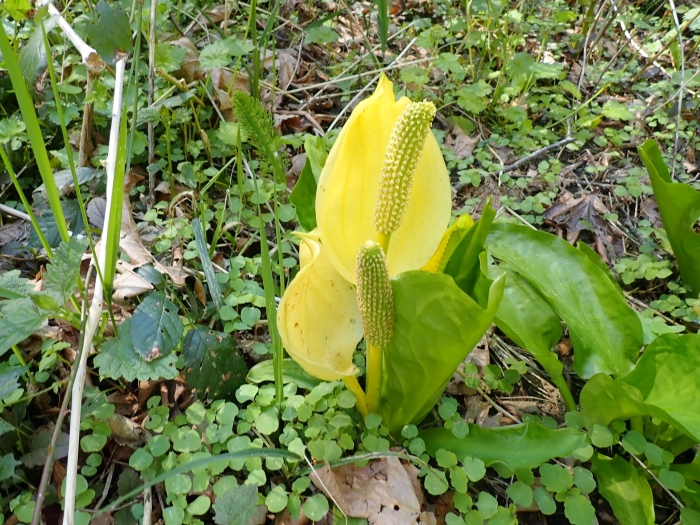American Skunkcabbage
(Lysichiton americanus)
American Skunkcabbage (Lysichiton americanus)
/
/

John Brew
CC BY 4.0
Image By:
John Brew
Recorded By:
Copyright:
CC BY 4.0
Copyright Notice:
Photo by: John Brew | License Type: CC BY 4.0 | License URL: http://creativecommons.org/licenses/by/4.0/ | Rights Holder: John Brew | Publisher: iNaturalist | Date Created: 2020-04-13T22:45:33Z |



















































Estimated Native Range
Summary
Lysichiton americanus, commonly known as American Skunkcabbage, is a semi-deciduous perennial herb native to wetlands, including swamps, wet forests, and stream margins in the Pacific Northwest of the USA and British Columbia. It typically grows from robust rhizomes that measure 30 cm or longer, and 2.5 to 5 cm in diameter. The plant’s most striking feature is its flowers, which are produced in a spadix contained within a large, bright yellow or yellowish-green spathe atop a 30–50 cm stalk. The flowers are numerous, densely packed, and bloom in late winter or early spring, making it one of the earliest flowering plants in its native habitat. The common name ’skunk cabbage’ comes from the distinctive "skunky" odor the plant emits when blooming, which attracts pollinators such as flies and bees.
American Skunkcabbage is appreciated for its early spring flowers and its ability to thrive in wet, marshy conditions, making it suitable for water gardens and naturalized areas. It requires consistently moist or wet soil and can grow in full sun to part shade. While it is low-maintenance once established, gardeners should be aware of its spreading nature and potential to become invasive outside its native range. It is also resistant to pests and diseases, making it a robust addition to suitable gardens. However, due to its invasive potential, it should be planted with caution and monitored for unwanted spread.CC BY-SA 4.0
American Skunkcabbage is appreciated for its early spring flowers and its ability to thrive in wet, marshy conditions, making it suitable for water gardens and naturalized areas. It requires consistently moist or wet soil and can grow in full sun to part shade. While it is low-maintenance once established, gardeners should be aware of its spreading nature and potential to become invasive outside its native range. It is also resistant to pests and diseases, making it a robust addition to suitable gardens. However, due to its invasive potential, it should be planted with caution and monitored for unwanted spread.CC BY-SA 4.0
Plant Description
- Plant Type: Herb
- Height: 1-2 feet
- Width: 1-2 feet
- Growth Rate: Slow
- Flower Color: Yellow, Green
- Flowering Season: Spring
- Leaf Retention: Semi-Deciduous
Growth Requirements
- Sun: Full Sun, Part Shade
- Water: Aquatic, High
- Drainage: Slow, Standing
Common Uses
Deer Resistant, Edible*Disclaimer: Easyscape's listed plant edibility is for informational use. Always verify the safety and proper identification of any plant before consumption., Low Maintenance, Potted Plant, Showy Flowers, Water Garden
Natural Habitat
Wetlands, including swamps, wet forests, and stream margins
Other Names
Common Names: American Skunk Cabbage, Western Skunk Cabbage, Yellow Skunk-Cabbage, Swamp Lantern, American Skunk-Cabbage, Western Skunk-Cabbage, Skunk Cabbage, Western Skunk Cabbage, Yellow Skunk Cabbage, Gul Kæmpekalla
Scientific Names: , Lysichiton americanus,
GBIF Accepted Name: Lysichiton americanus Hultén & H.St.John